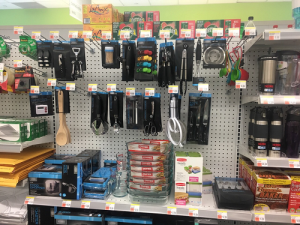Housewares, Household & GM: Trends & Opportunities 8/7/2017
The great thing about the housewares, household and general merchandise categories is that they provide retailers with the opportunity to offer their shoppers a continually-changing mix of innovative products, giving them a reason to keep coming back to their stores.
Indeed, Lidl, which has already opened more than 20 stores on the East Coast with plans for as many as 100 by years end, is planning to leverage this fact to drive traffic. A recent MMR article reported that the retailer has a changing selection of nonfoods each week, including fitness gear, kitchen appliances and toys (more on Lidle in a bit).
At ECRM's recent Housewares, Household & General Merchandise EPPS, buyers reviewed products from a variety of categories including household chemicals, storage solutions, kitchen gadgets, and other general merchandise offerings. Based on staff interviews with buyers and suppliers during the EPPS, there were certain key themes that kept coming up in conversations. Here they are:
As Seen on TV: This category continues to grow in popularity, with lots of new products entering on a regular basis. The great thing about these items is the combination of the TV advertising and the unique merchandising opportunities they present; retailers typically allot an end cap or section on the shelf dedicated to these products, and the continuous refreshing of the product lineup drives shoppers to it regularly. It's usually the go-to place in the store for novel and innovative items.
Novelty and Innovation: And speaking of new and novel products, this was another key area of interest. As one buyer put it, they are interested in “finding things that consumers don’t yet know that they want,” and novel and innovative items that address needs in a new or unique way (even if that need is to provide a distraction in the case of the hugely popular fidget spinners) can provide incremental revenue for retailers.
The two Buyers Choice Award winners are an example of this. StubbyStrip’s FlexiKooler 6-pack beverage carrier, which took first place, is a great example of this. It features individual, easy-to-share cozies which can sleeve any drink from a small Red Bull all the way up to a 2L hydration or water bottle, according to the company. Finalist Nkd life produces a nkd Pod water filtration device developed to remove harmful contaminants from water – such as bacteria, viruses and parasites -- while ionizing, alkalizing and increasing antioxidants.
Organization and Storage: Products that help organize the home and remove clutter were very popular among buyers attending the EPPS, particularly those food storage items that are both functional and stylish. Basically, any general merchandise products that enable people to make more from the space that they have are in demand. This fact is also driving consumers toward wipes and pods for household cleaning and laundry – these items require less space and are positioned as more convenient to use than liquid cleaners and detergents, and are increasingly finding their way into consumers pantries. We saw a lot of innovation in this area at the EPPS.
Product Density: Consumers aren’t the only ones looking to make a better use of their space – retailers are as well, and when it comes to household chemicals less it's definitely more, particularly when "less" refers to less space needed on the shelf and in the delivery truck. One example of these types of products is bleach tablets that were developed by one of the suppliers I had the privilege of observing in a buyer meeting. According to the supplier, one box of the bleach tablets equates to the effectiveness of a gallon jug of bleach, which is mostly water, and you could fit approximately eight of these boxes in the space that the gallon jug would need, providing much more dollar sales for the same amount of space. Plus, on the back end, there would be less supply chain costs to move the product from the warehouse to a retailer’s stores.
Ingredient Callouts: One issue that I observed retailers having with household chemical suppliers though, is the fact that some of them are listing the product’s key chemical ingredients on the front of the packaging, rather than the functional benefits that these chemicals deliver. Remember, consumers are not chemists (most aren’t anyway), so listing these chemicals on the front of the package isn't going to impress them. Instead, the retailers prefer the benefits of the product or chemical to be called out on the front of the packaging, in a language that these consumers will understand.
Lidl and Bulk Paper Products: One impact of Lidl’s entrance onto the retail scene is that retailers are beginning to explore bulk programs, particularly in private label paper goods, to help prevent shoppers from flocking to the new retail chain’s stores for them. This includes one-off deal programs in which they can offer a deep discount. While this is primarily a concern for retailers on the East Coast, retailers in other areas are paying close attention, as Aldi, in a pre-emptive move, may respond in kind with similar programs in other areas of the country.
CLICK HERE TO REGISTER FOR NEXT YEAR’S HOUSEWARES, HOUSEHOLD AND GENERAL MERCHANDISE EPPS

